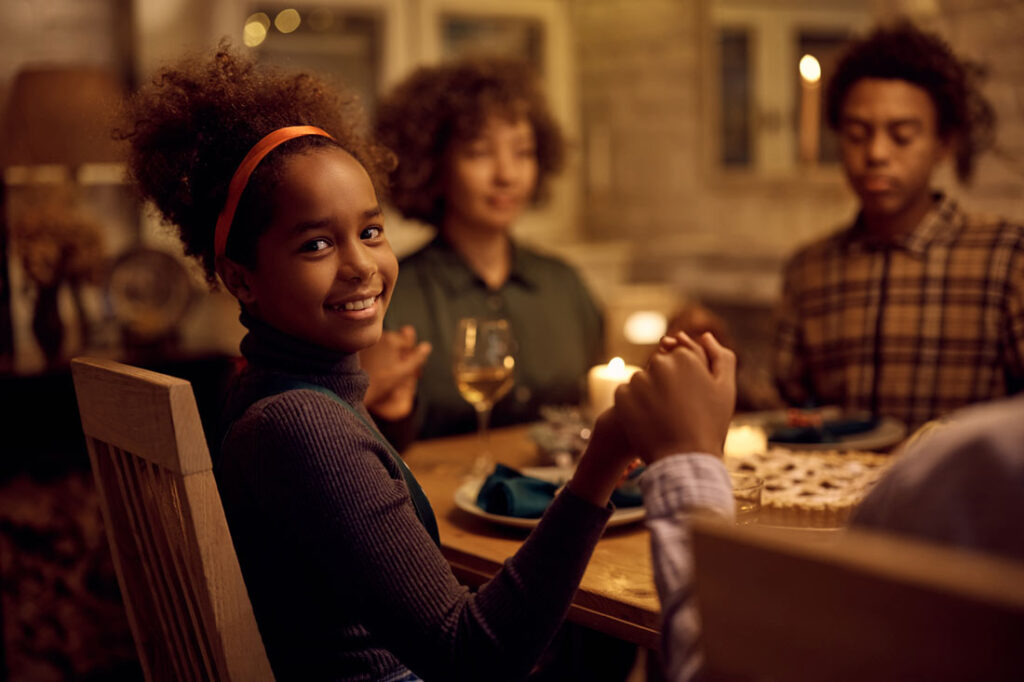As Thanksgiving approaches, we’re probably all spending a little more time thinking about things we’re grateful for. But what if gratitude wasn’t just something we talked about with our families every November and, instead, was something we consciously practiced all year? That’s the world Ricky Mendez wants to live in. As a self-proclaimed “gratitude enthusiast” and implementational speaker, Mendez’s work in mindset and prosperity planning includes a focus on gratitude. He’s even working on a children’s book about teaching kids gratitude.
“If you want to make change, I don’t think there’s any better way to start than with young kids,” he says. “Because they’re like, the eternal optimists. They haven’t been guarded with a ton of negativity and pessimism.”
Here are 4 tips on teaching kids gratitude from Mendez
We sat down with Mendez to talk about how to teach kids gratitude and to learn some simple steps you can take to get kids thinking gratefully from a young age—skills that can also apply at any age.
1. Talk about what gratitude is.
Maybe it seems obvious, but the starting point here is to get everyone on the same page regarding gratitude. “With kids, I just ask: Do you know what gratitude means? That’s it,” Mendez says. If they don’t know, he gives them a quick definition and asks if that makes sense. But there’s no right or wrong answer here, really. It’s about sparking a new dialogue between parent and child. This is the first building block for future conversations.

2. Small gestures are A-OK!
Don’t feel like your young ones should start by making huge, sweeping declarations of gratitude; your kids don’t need to write a novella here. Mendez says, when teaching kids gratitude, it’s better to spend 30 seconds a day thinking about what they’re thankful for rather than spending hours on the subject once and then never addressing it again. “It’s gonna force them to go down a rabbit hole that they’re probably not used to going down, which means change, and change is difficult for our brains, because it’s going against what we’re used to,” Mendez says. Little steps, implemented over time, will be easier to manage.
3. Stay consistent when teaching kids gratitude.
Like all lifestyle changes, adopting a gratitude mindset can require some time to adjust. At first, as they start to talk about this new thing, “kids are going to get excited—that’s one thing I feel extremely confident in saying,” Mendez says. But as anyone who’s tried to stick to a new gym regimen or introduce healthy eating habits knows, keeping with it over time can be hard, even if the initial enthusiasm is there.
The trick is to not let that spark of excitement burn out too quickly. Mendez calls this the “fun work,” but it’s also the tough part. One thing that can help is to have a routine. Maybe dinnertime is when you and the kids talk about what you’re grateful for that day, or maybe you talk about it as they get ready for bed each night.
4. Maintain your enthusiasm and mirror theirs.
Want to raise kids who are full of gratitude? When teaching kids gratitude, it helps if you’re full of gratitude, too. “In order for us to expand that message, we have to expand ourselves,” Mendez says. When your young ones talk about what they’re grateful for, it’s important to match their energy and excitement and ask them questions to help stoke their enthusiasm. These might be emotional conversations, and they’ll require grown-ups to do some reflecting on their own feelings of gratitude. “I think that’s where real change can be created,” Mendez says.
This article was updated November 2023. Photo by Drazen Zigic/Shutterstock.com










